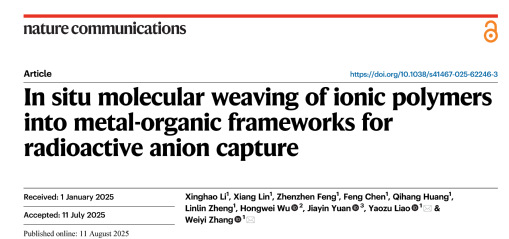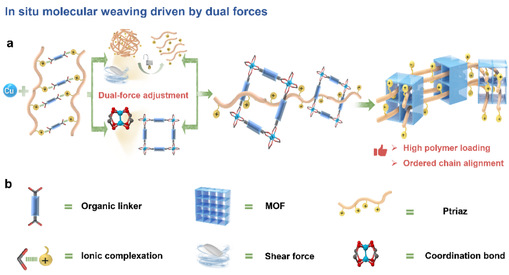Approximately 60 naturally occurring radioactive nuclides exist in nature, while over 2,000 have been artificially synthesized. These nuclides serve as vital resources for industrial detection, nuclear energy, and deep space exploration. Efficient separation and recycling technologies represent a critical bottleneck in China's nuclear resource recovery system. Advancements in this technology are of paramount importance for safeguarding national strategic resource security and promoting the sustainable development of nuclear energy. Technetium-99 (⁹⁹Tc) is a representative fission product characterized by high toxicity, high production yield, and prolonged radioactivity, with a half-life extending to 2.13×10⁵ years. Within the nuclear industry, ⁹⁹Tc predominantly exists as the peroxodioxide ion (⁹⁹TcO₄⁻). Upon accidental release, these ions readily migrate through the environment and enter the food chain. Leveraging the high specific surface area of metal-organic frameworks (MOFs), incorporating cationic polymers into MOFs to construct ionic polymer–MOF composites is considered a potentially viable strategy for sequestering such radioactive anions. However, conventional preparation methods commonly face challenges such as polymer chain entanglement, low loading capacity, and insufficient exposure of active sites. To address these issues, the research group led by Professor Liao Yaozu at the College of Materials Science and Engineering conducted pioneering research. They innovatively proposed an ‘in-situ molecular weaving’ technique, enabling the ordered confinement and construction of polymer chains within MOF channels. This approach resulted in structurally uniform ionic composites with outstanding adsorption performance.

Recently, this research achievement was published in the international journal Nature Communications (2025, 16, 7393) under the title ‘In situ molecular weaving of ionic polymers into metal-organic frameworks for radioactive anion capture.’ The paper's first author is Li Xinghao, a doctoral student at our university, with Liao Yaozu and Zhang Weiyi serving as corresponding authors.

(molecular weaving of ionic polymer–MOF composites induced by dual forces)
This work employs an in-situ molecular weaving strategy, leveraging the synergistic effects of shear forces and coordination bonds to disentangle linear cationic polymer chains during MOF formation. These chains are then ordered within the nanochannels of the MOFs, achieving uniform polymer distribution. The resulting ionic polymer–MOF composite (MW-Ptriaz@MOFs) exhibits an adsorption capacity of 438 mg/g for the radioactive anion substitute ReO₄⁻ (a non-radioactive analog of ⁹⁹TcO₄⁻), reaching adsorption equilibrium within 20 minutes. It maintains relatively superior selective adsorption performance even under strong acidic conditions and in the presence of competitive anions at a hundredfold excess.
The ‘in-situ molecular weaving’ strategy proposed in this study not only opens new avenues for structural regulation and performance optimization of multifunctional composite adsorbents but also lays a solid theoretical foundation for the subsequent design of high-performance ionic composite materials. This research was jointly funded by the National Natural Science Foundation of China, the Shanghai Key Technology R&D Program, and the Central University Basic Research Fund.
